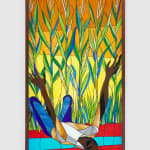-
Artworks












Nat Turner, 2022
Stained glass lightbox93 x 47 1/2 x 5 in.
236.2 x 120.7 x 12.7 cmSoldFurther images
-
(View a larger image of thumbnail 1
)

-
(View a larger image of thumbnail 2
)

-
(View a larger image of thumbnail 3
)

-
(View a larger image of thumbnail 4
)

-
(View a larger image of thumbnail 5
)

-
(View a larger image of thumbnail 6
)

-
(View a larger image of thumbnail 7
)

-
(View a larger image of thumbnail 8
)

-
(View a larger image of thumbnail 9
)

-
(View a larger image of thumbnail 10
)

-
(View a larger image of thumbnail 11
)

-
(View a larger image of thumbnail 12
)

In his 'Confessions' Nat Turner reveals that God communicated with him both directly through visions and indirectly through signs in the natural world. In a field one day, he found...In his "Confessions" Nat Turner reveals that God communicated with him both directly through visions and indirectly through signs in the natural world. In a field one day, he found “drops of blood on the corn as though it were dew from heaven.” Myers depicts Turner recumbent in this field of corn, hands raised in divine ecstasy. The structure of the composition is drawn from Caravaggio’s "The Conversion of Saint Paul," which records the moment when Saul of Tarsus, on his way to Damascus to exterminate its Christian community, is struck blind by a bright light. He hears the voice of Christ and is converted to a believer. Myers, like Caravaggio, constructs a crisis of revelation and dislocation, in which God disrupts the mundane world. Here, the artist taps into a rich vein of art-historical iconography to bring Nat Turner into visual conversation with the Christian saints with whom he saw himself aligned.Provenance
Private Collection, Houston (JCG)1of 2 -
(View a larger image of thumbnail 1
)











